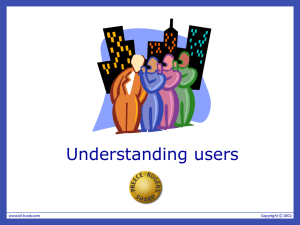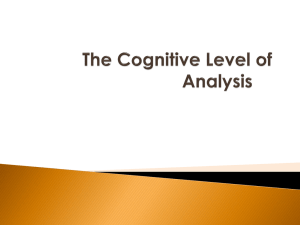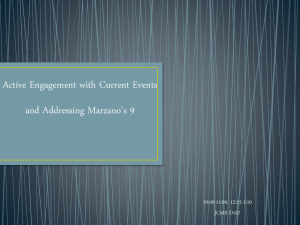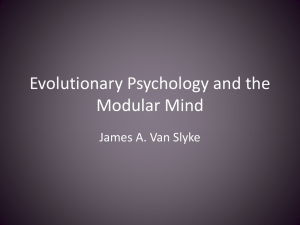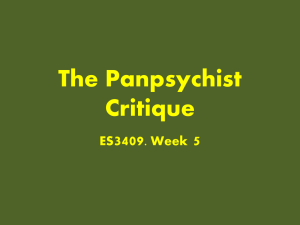What IS a mental process - KR
advertisement
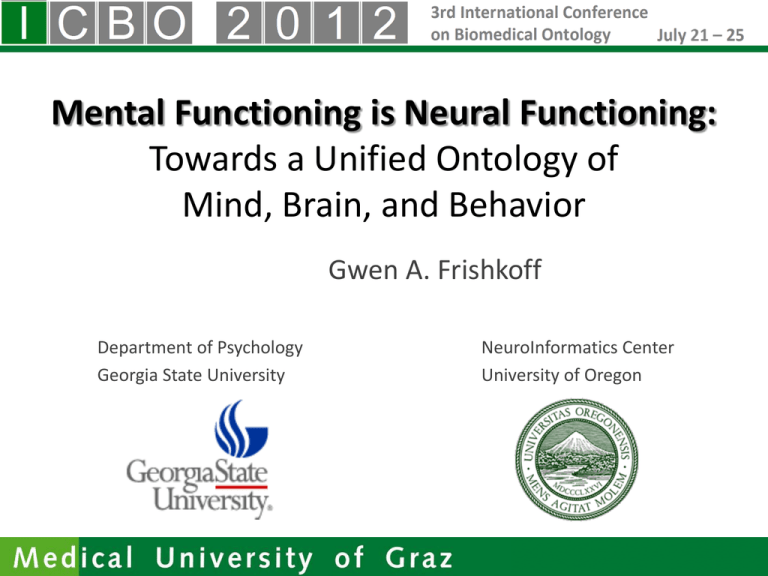
Mental Functioning is Neural Functioning: Towards a Unified Ontology of Mind, Brain, and Behavior Gwen A. Frishkoff Department of Psychology Georgia State University NeuroInformatics Center University of Oregon Outline of Talk • What is a mental process? – A view from cognitive psychology – The Mind–Brain problem and three proposed solutions (ontology views) • A neurophsysiological framework for understanding mental processes – Levels of brain, levels of mind – What are mental representations “about”? (Proposed solution to problems of subjectivity, aboutness) Outline of Talk • What is a mental process? – A view from cognitive psychology – The Mind–Brain problem (redux) and three proposed solutions (ontology views) • A neurophsysiological framework for understanding mental processes – Levels of brain, levels of mind – What are mental representations “about”? (Proposed solution to problems of subjectivity, aboutness) What is a Mental Process? A view from cognitive psychology Sensation, Perception Short-term memory Cognitive control Motor control, Action Long-term Memory Habits & Skills How do we know any of this? That is, where did the components of the standard model come from? The mind as a black box • • X Mental processes cannot be observed.* They must be inferred based on what we can observe. What can we observe?... *We can revise this assumption later (if Mind = Brain) What we can observe… and How • Physical processes in body Behavior (response type, accuracy, reaction time) • Physiological processes in brain Neural activity and correlates of neural activity (blood flow to brain regions) A schematic of Helmholtz’s apparatus for measuring the time course of muscle contraction and the propagation velocity of the nerve impulse. Source: Bennett, 1999. CogPO! A 256-channel electrode “net” that is used to measure brain electrical activity (EEG) What IS a mental process*? * “process” and “function” are used interchangeably in this talk What IS a mental process? NOTE: Dotted line designates indirect link within subsumption hierarchy Three proposed solutions Outline of Talk • What is a mental process? – A view from cognitive psychology – The Mind–Brain problem (redux) and three proposed solutions (ontology views) • A neurophsysiological framework for understanding mental processes – Levels of brain, levels of mind – What are mental representations “about”? (Proposed solution to problems of subjectivity, aboutness) “A mental process is NOT necessarily a physical process.” ⇒ Mental processes could be something qualitatively different from bodily and brain processes; aka Dualism (Mind ≠ Brain) ARGUMENTS IN FAVOR ARGUMENTS AGAINST • Can accommodate lay view • Imprecise (what kind of process…?) • Can explain properties of mind: subjectivity aboutness • Unclear how Mind and Brain are related • Unnecessarily complex “A mental process is a physical process, but is NOT necessarily a neural process.” ARGUMENTS IN FAVOR • Avoids Mind-Body dualism • More precise than Solution #1 ARGUMENTS AGAINST • Still somewhat imprecise (what kind of bodily process…?) • Does not make explicit the relationship between mental and neurophysiological processes “A mental process is a neural process.” ARGUMENTS IN FAVOR • Avoids Mind-Body dualism • More precise than other two solutions • Gives ready framework for comparative neurophysiology & comparative cognition • Knowledge of brain structure & function informs understanding of mental function (and dysfunction) Outline of Talk • What is a mental process? – A view from cognitive psychology – The Mind–Brain problem (redux) and three proposed solutions (ontology views) • A neurophsysiological framework for understanding mental processes – Levels of brain, levels of mind – What are mental representations “about”? (Proposed solution to problems of subjectivity, aboutness) A neurophysiological framework for understanding types of mental process • Unimodal regions: sensory and motor cortex • Hetermodal regions Heteromodal association cortex: “cognitive” functions Paralimbic regions: emotion and motivation, selfregulatory functions Levels of brain, levels of mind Representation, monitoring and control of bodily interface to external environment (“real world”) Representation, monitoring and control of internal environment (“self”) Mesulam, 1990 18 Mental representations: What are they “about”? Sensoy-motor maps in the brain Peripheral (sensory-motor) parts of the body are “mapped” to (represented by) an orderly set of discrete regions within sensory and motor cortex. Maps of the internal milieux The Hypothalamic-Pituitary-Adrenal (HPA) Axis monitors and controls internal bodily functions, such as blood circulation, breathing, digestion, stress, and arousal. Perception of internal (bodily) environment (“self”) Perception of external environment/ sensory input (“real world”) 20 Mental processes, states, and representations Summary • What is a mental process? – A view from cognitive psychology – The Mind–Brain problem (redux) and three proposed solutions (ontology views) • A neurophsysiological framework for understanding mental processes – Levels of brain, levels of mind – What are mental representations “about”? (Proposed solution to problems of subjectivity, aboutness) Acknowledgements Funding from the National Institutes of Health (NIBIB), R01-MH084812 (Dou, Frishkoff, Malony)

